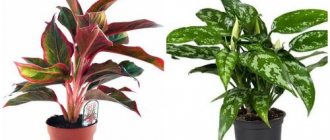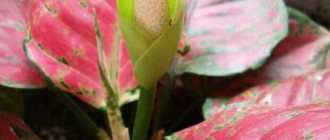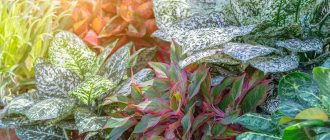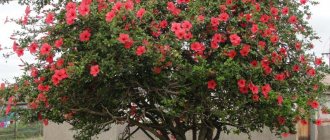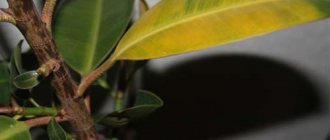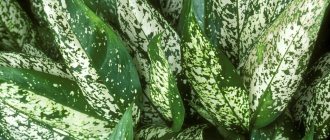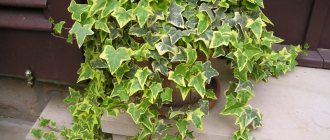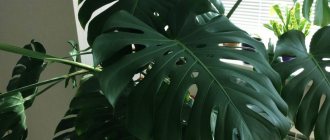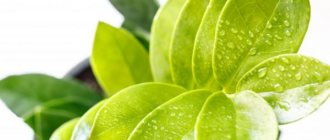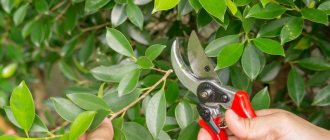Author: Elena N. https://floristics.info/ru/index.php?option=com_contact&view=contact&id=19 Category: Houseplants Published: January 07, 2012Republished: February 7, 2019Last edits: March 12, 2021
- Aglaonema shiny / Aglaonema nitidum
2. Propagation of indoor plants
Throughout its life, the plant produces lateral shoots and basal suckers , which are used for vegetative propagation in spring or summer.
- Cuttings of aglaonema are best done in a special heated container, in vermiculite.
- Often cuttings take root even in a simple glass of water. You can even plant stems that have taken root and do not have leaves - they will begin to grow from the awakened lateral buds and will produce additional shoots from the buds that are located underground.
- Such stem cuttings should be placed horizontally, lightly sprinkled with moist soil - this will make the plant more lush, because leaves and roots will appear in each dormant bud.
- The successful completion of the rooting process will be indicated by the appearance of signs of new growth - young shoots.
Many varieties of Aglaonema are propagated by seeds and air layering . Seeds germinate in 25 - 30 days. For propagation, only freshly collected seeds are used.
Large adult specimens are propagated by division , which is carried out in the spring, during transplantation. The bushes are divided in such a way that each part ultimately receives its own, well-developed root system and green ground part.
↑ Up,
Propagation of Aglaonema by cuttings
The plant reproduces throughout the growing season. It must be healthy and tall. Most often, propagation is carried out by root suckers, division of the mother plant, seeds and stem cuttings. We will talk about the last type of reproduction.
You might be interested in this flower:
Chlorophytum: methods of reproduction, difficulties of cultivation, diseases and pests, home care, photos of species
So, propagation of aglaonema by cuttings is considered a labor-intensive and time-consuming process.
First, the upper part of the shoot is cut off from the stem. When cut, the plant is treated with charcoal. You can also use activated carbon (2-3 tablets). In pre-prepared, moistened peat and sand mixed in equal proportions, a cutting with two buds is planted to a depth of 4-5 cm.
It is better to root aglaonema in small greenhouses with fertile soil. Therefore, at home, the container where the sprout is located is covered with cellophane or a transparent cap. At room temperature, adventitious roots will be formed after 30 days.
After the cuttings have taken root, they are planted in small pots or in different flowerpots separately.
Cuttings are best done in spring and summer. When placing flowerpots with young seedlings on window sills, it is better to choose the northeast or northwest.
4.Aglaonema - home care
4.1.Soil
Well-drained, loose, moisture-permeable soil made from leaf humus, coarse sand, peat, heather soil.
The substrate should have good drainage and easily allow both moisture and air to pass through to the plant's root system.
↑ Up,
4.2.Watering
abundant watering during warm periods. In winter, the frequency of watering is reduced, but without allowing the earthen clod to dry out.
The flower suffers from excessive watering and stagnation of water in the pot.
Drain excess water from the pan within a few minutes after watering.
Water only with warm, soft water; the frequency will depend on the temperature and the degree of illumination.
↑ Up,
4.3.Growing, how to prune
Aglaonema is quite capricious and often does not forgive violations of agricultural practices.
The plant does not tolerate low temperatures well - it curls the tips of the leaves and does not like cold drafts.
During the winter months, plants often develop some yellow leaves at the base.
Tall varieties may require support to grow.
Plants will appreciate periodic bathing in the shower during the warmer months.
It is worth pinching old, yellowed leaves in a timely manner.
To prevent the plant from wasting its energy on forming flowers, the buds immediately removed . Pruning is carried out only with a sharply sharpened and sterile instrument.
In the summer months, you can take the flower out into the fresh air , placing it in a place where it will be protected from direct sun, strong gusts of wind and rain.
4.4.Lighting
Green-leaved varieties are shade-tolerant and suitable for poorly lit rooms; they can get burned when exposed to direct sunlight.
When grown indoors, variegated varieties, especially red ones , need more sunlight than green ones.
If aglaonema lacks sunlight, use artificial illumination with fluorescent lamps.
↑ Up,
4.5. Fertilizer of aglaonema
Flowers in pots have a limited feeding area and need regular feeding .
In the summer, every 2 weeks we feed the aglaonema with flower fertilizers with a minimum amount of lime; We do not feed the plant in winter.
4.6.Temperature
House flowers grow well at room temperature, during the period of intensive growth - 20 - 25 ° C. The minimum temperature in winter is not less than 15°C , although it can briefly withstand a drop of up to 10°C.
The flower comes from tropical latitudes; it does not require a winter dormancy period, although it is welcome.
The plant does not like sudden changes in temperature and intense summer heat (more than 26 ° C).
↑ Up,
4.7.Air humidity
Likes regularly ventilated rooms, however, without cold drafts.
Aglaonema prefers high air humidity and regular spraying with soft water, but it tolerates dry air only for a short time.
A flower pot can be placed in a tray with wet pebbles or sphagnum moss; a room humidifier or a decorative fountain can also be used to increase humidity.
↑ Up,
How to make aglaonema bush?
New shoots of aglaonema
In good light, aglaonema bushes on its own quite willingly, often produces babies, and this process does not require additional intervention.
However, if you think the plant needs help forming a thick head of leaves, carefully remove the last two young leaves from the center of the rosette. Firmly grasp the leaves where they emerge from the central rosette and gently pull them upward. The leaves should come out whole, without breaking off. In this case, the plant will use its strength to increase the size of existing leaves and produce children, which will add splendor to the bush. There is no need to cut off the top leaves with scissors. In this case, most likely, the growing point will not be lost, and the plant will continue to produce new leaves from the central rosette.
6. Transplantation of aglaonema
Replant as necessary - about once every three years , since the plant grows rather slowly.
Don't use a pot that's too big—aglaonema grows best when its root system is cramped .
Try not to disturb the root system again and use transshipment along with a lump of earth.
When transplanted, adult plants that form a trunk are placed horizontally - at the same time, dormant buds wake up on the stem and each of them forms its own leaves. As a result of this procedure, you can get a chic, lush plant.
Planting in fresh soil is carried out in the spring , when the plant wakes up and demonstrates its readiness to develop.
↑ Up,
Why do Aglaonema leaves turn yellow?
The variety of colors of aglaonema leaves is amazing.
Yellowing of leaves is the most common problem with aglaonema. It is typical for any species - both with green leaves and colored ones.
Natural growth and aging Yellowing and dying of old lower leaves is a natural process: this is how the plant rejuvenates and continues to grow.
Bay However, if yellow leaves appear too quickly one after another, and the plant loses its decorative appearance, then most likely the reason is the flood. We told you how to water aglaonema - try to follow these instructions.
To stop the process of yellowing of leaves, dry the earthen ball. Drying in the pot will be sufficient if the soil is moderately moist and the temperature of the room where the aglaonema grows is not lower than +22. Just stop watering for a week or two - be guided by the condition of the soil.
If the room is cool, then it is better not to leave the alaonema in a wet pot. Remove the plant along with the earthen lump and let it dry outside the pot. At the same time, check the condition of the roots - due to high humidity, rot easily develops. Remove rotten roots. It is optimal to sprinkle the sections with a fungicide - an excellent option is phytosporin. You can lightly dust the entire root system with it before planting for prevention. After the earthen ball has dried sufficiently, you can put the aglaonema back into the pot. If the soil is very wet and does not dry out (for example, poorly aerated, heavy), take the opportunity to replace it. Carefully remove the remnants of the old soil from the roots and replant them into new soil.
Adaptation after moving, rearranging, purchasing If yellow and dry leaves appeared after acquiring aglaonema / moving the plant to a new place, then the matter may be a shock due to the move, which is common for many plants. Provide the aglaonema with the necessary conditions for light, temperature and watering, cut off the leaves that have lost their decorative effect and wait for the flower to adapt to the new conditions. You can help aglaonema a little by treating it with any adaptogen.
8.Note
Do not grow this plant in homes where there are children and animals, as its juice and berries are poisonous .
After 3 - 4 years, the plant begins to lose its lower leaves, exposes the lower part of the shoots and becomes untidy - it needs to be renewed . Replace it with a young bush by cutting and rooting the top.
Aglaonema grows best in a tropical " flower window " with constant temperature and humidity.
These decorative leafy bushes are able to purify the indoor air from many harmful impurities - for example, formaldehyde and benzene.
From time to time you can notice small transparent droplets on the leaves - the plant seems to be “ crying ”. There is nothing wrong with this - it’s just that at this time the flower is kept in high air humidity or the weather outside is cloudy and rainy.
↑ Up,
Diseases and pests of aglaonema
Aglaonema leaves wrinkle and the tips turn brown. The air humidity in the room is too low, and dry air is not beneficial; it can also attract pests. Spray the leaves, and the pot can be placed on a container with wet expanded clay or peat.
Aglaonema leaves curl. In aglaonema, this happens if the plant is in a draft, or during sudden drops in temperature. Usually, along with this, the edges of the leaves turn brown.
Yellow-white spots appear on the leaves of aglaonema. This happens if the plant stands in the sun - these are burns. The plant should be removed to a shaded place, allowed to cool, and then spray the leaves with water at room temperature.
The leaves turn brown, aglaonema slows down growth. The reason is watering with cold or hard water. Before watering, the water should sit for 24 hours. You can soften the water by adding 0.2 g of oxalic acid to 10 liters of water, after which the water should stand for a day. You can also use citric acid to make the water softer.
Aglaonema pests. Aphids, spider mites, whiteflies, mealybugs and thrips are the pests that most often harm aglaonema.
10.Types of aglaonema:
10.1.Aglaonema changeable - Aglaonema commutatum
One of the most common species of this genus. An evergreen herbaceous perennial of small height - about 50 - 60 cm. The leaves are variegated, striped, thick, spear-shaped, shiny, the main tone is dark green, have an attractive silver marking along the main vein, the length of the leaf plate ranges from 10 to 30 cm, width - from 4 to 10 cm. The leaves are located on short, erect, sometimes branched, glossy green stems, reaching two meters in height for several years. This aglaonema blooms rarely, the peduncles are tall - up to 20 cm, the flowers are axillary with a pale green veil, collected in an inflorescence - a spadix, usually appear at the end of summer - until the beginning of autumn. The flowers are small and inconspicuous, reminiscent of small greenish-white callas.
The fruit is a yellow oval berry that changes color to bright red, less than 1 cm in length, which gives the plant additional decorativeness. The plant resembles Dieffenbachia in appearance and is used as an ornamental foliage plant. An easy-to-care plant that prefers loose, rich soil and plenty of watering. Varieties of aglaonema changeable differ in the color of their leaves; it is worth remembering that the more pronounced the variegation, the more the plant needs light.
↑ Up,
10.2. Curly Aglaonema or Robelena - Aglaonema roebelenii
An evergreen perennial, about 1 m high. The stems are densely covered with long, elliptical, hard, leathery leaves with silver-gray veins and dark green edges on short petioles. The length of the leaves ranges from 20 to 30 cm, the width is between 8 and 13 cm. It is grown mainly in greenhouses and winter gardens due to its large size for its variegated leaves. The flowers are relatively long, greenish and not particularly noticeable. They attract more attention when they turn into red berries. Aglaonema curly requires warm conditions throughout the year and diffused light or partial shade; it does not tolerate direct sunlight.
↑ Up,
10.3. Aglaonema Maria - Aglaonema Maria
An evergreen ornamental foliage plant with oblong dark green leaves covered with light green transverse stripes. It is resistant to low light levels. It successfully tolerates short droughts and is successfully grown under artificial lighting.
↑ Up,
10.4. Aglaonema Silver Bay - Aglaonema Silver Bay
A large plant - the bush reaches 1 m in height. The large leaves of this plant are distinguished by a light green or silver-gray base tone and a darker edging of the leaf blades. This plant tolerates a wide range of temperature conditions and grows well under artificial light. Aglaonema Silver Bay tolerates both short droughts and floods.
↑ Up,
10.5.Aglaonema Crete - Aglaonema Crete
This variety is also called “red aglaonema” because of the distinctive color of the leaves - they have a salmon or pink edge and spots of the same color scattered on the leaf blades. The underside of the leaf blades is also painted pink. A very stylish, elegant plant. Aglaonema Crete does not like bright lighting.
↑ Up,
10.6. Aglaonema painted tricolor - Aglaonema pictum
A spectacular ornamental, slow-growing subtropical houseplant. This variety has large, glossy, narrowly oval leaves. The leaf blades are dark green with lighter green and almost white spots, reminiscent of camouflage. With age, these flowers form strong stems covered with light brown bark. Even adult specimens remain compact and often do not exceed a height of 30 cm.
↑ Up,
10.7.Aglaonema pseudobracteatum
Narrow-leaved aglaonema with dark green, glossy, pointed leaves on long, relatively thin petioles. The surface of the leaf blades is abundantly covered with light green and white spots, and the central vein is highlighted in green.
↑ Up,
10.8. Aglaonema ribbed - Aglaonema costatum
Slow-growing, large-leaved bushes up to 60 cm high with oblong, pointed leaves up to 20 cm long. The leaf blades are emerald green or very dark, almost black, the central leaf vein is highlighted in a lighter shade.
↑ Up,
10.9.Aglaonema oblong-leaved - Aglaonema marantifolium
Perennial evergreen plants with oblong-elliptical glossy leaves on long, thin petioles. The leaf blades are dark green, with small light green and transverse stripes. Plants are tall and can reach a height of 60 cm.
↑ Up,
10.10.Aglaonema modest or moderate - Aglaonema modestum
These plants are considered one of the most useful in the house - they can effectively cleanse the polluted atmosphere of many harmful impurities. In addition to its benefits, this plant surprises with its attractive appearance - it has broadly lanceolate, glossy, entire leaves, colored dark green. Variegated varieties are distinguished by the presence of light green and white spots and stripes.
↑ Up,
Description of the plant
Aglaonema is a herbaceous evergreen perennial that lives in shady forests and near the shores of reservoirs. The maximum height of the clump is 70 cm. A short fleshy stem with frequent internodes grows from the ground. On long petioles, lanceolate or broadly oval leaves with a pointed edge are attached to the stem. The length of the shiny leaf plate is 10-15 cm. It can be painted in a single dark green color or have a complex marble pattern of several shades of silver, blue, green and pink. A raised central vein stands out on the smooth surface of the leaf.
Aglaonema blooms in summer, but not every year. A cob-shaped inflorescence with a large veil resembling a sail blooms on a long peduncle. The flowers are not expressive; they are colored yellow-green. After pollination, round scarlet berries with a single seed are formed. Seeds remain viable for only 6-8 months.
Aglaonema juice is irritating and can cause poisoning. It is better to carry out all work with the plant wearing gloves. The flower pot should be kept away from children and pets.
Agricultural technology
The 70s began the spread of aglaonema, and in this century breeders were able to obtain hybrid forms of the plant in large quantities. The plant belongs to the araceae family, but caring for it is much easier than for its decorative growing relatives. Here are a few points to follow:
— For planting, give preference to light and loose soil.
- Based on the description, it is not difficult to understand that direct sunlight will not be to the liking of the aglaonema. In the shade, the leaves become saturated, and the color only becomes more contrasting.
— Water infrequently with warm water (the plant tolerates a one-time mistake) and do not forget to care for the leaves with a damp cloth and spraying from a spray bottle.
— Choose a wide container for growing; drainage is not necessary.
Aglaonema leaves “describe” the state of the plant. From them you can determine that there is not enough fertilizer and nutrition, as well as diseases. The leaves may become covered with dots, the leaves become withered and drooping, the color disappears, and the edges dry out around the perimeter.
Lighting and air temperature
A pot with a plant cannot be placed on a windowsill that is located on the sunny side. Bright, hot rays can cause leaf burns. Therefore, it is better to choose partial shade. It is also important to consider the type of flower. For example, those species whose leaves are brightly colored should be installed in places with bright but diffused light.
In the winter season, additional lighting of Aglaonema should be provided. The total duration of the plant's exposure to light is at least 15 hours.
The flower should be protected from drafts and exposure to tobacco smoke. The ideal place for Aglaonema is a well-ventilated room, but not the kitchen.
In summer, the optimal temperature range is from 20 to 25 degrees. Lower values are suitable for winter. The air must be moist. The figure is 50-60%. If the leaves of the plant dry out, it means it is standing too close to the heating devices. A large pan filled with water will help reduce their negative impact.
Types and varieties
Aglaonema roebelenii with large silver stripes on the leaves.
A. commutatum pseudobracteatum
Aglaonema pseudobracteatum with beautiful golden spots on the tip and base of the leaf.
A. trewbii Silver Queen with green leaves 12-15 cm long with silvery green specks.
A. pictum with green straight leaves and cream spots.
Aglaonema modestum with dark green, oval-shaped leaves without light stripes.
Problems of growing aglaonema
Brown edges of leaves, limp leaves - too infrequent watering, too dry or cold air, or vice versa - excessive watering, long drying of the soil. To understand the reason, dig the soil deeper and determine whether it dries out enough before the next watering.
Yellowing of aglaonema leaves - when watering with hard chlorinated water, lack of light.
Dry, brown tips of the leaves are due to insufficiently humid air; after all, aglaonema is a plant of tropical rainforests. It is necessary to increase the humidity around the plant. The cause may also be a lack of nutrients in the soil or their excess. Remember when you transplanted the plant and into what soil.
Loss of color - too bright light; midday sun can cause burns: first the leaves turn pale, then gray or brown oblong spots appear. If there are stains, it doesn’t hurt to check if there is a pest.
Watering and spraying
Aglaonema, even growing at home, is classified as a moisture-loving plant, which is easy to understand if we remember its main habitat - tropical and rain forests. From spring to autumn, the flower should be watered no more than once every 7 days.
Important! For irrigation, use only settled and soft water. Its temperature is close to or equal to room temperature.
A mandatory rule is that between waterings the top layer of soil must dry to a depth of no less than 3 cm. Ignoring it leads to stagnation of moisture and, as a result, the development of fungal infections. In cases where water passes freely through the ground and ends up in the pan in full, you should check the condition of the drainage and drainage holes.
Water Aglaonema very carefully, avoiding moisture getting on the leaves. Otherwise, aesthetically unattractive stains and stains will form on the sheet plates, as in the photo. For this reason, it is not recommended to spray the flower to increase humidity. It is permissible to wipe with a cloth moistened with water for irrigation.
